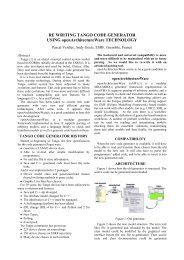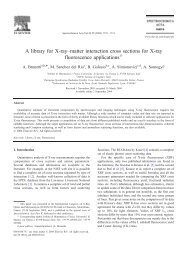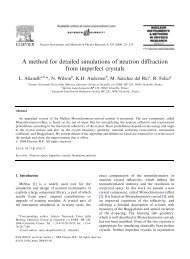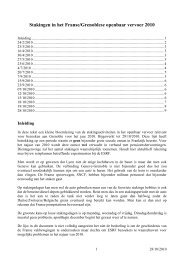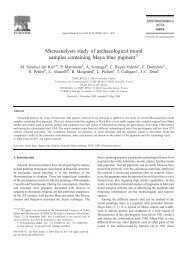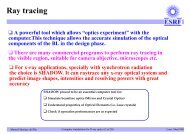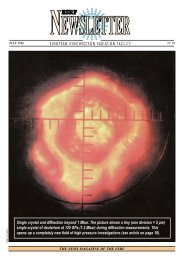Report on future detector requirements at ESRF
Report on future detector requirements at ESRF
Report on future detector requirements at ESRF
Create successful ePaper yourself
Turn your PDF publications into a flip-book with our unique Google optimized e-Paper software.
Sp<strong>at</strong>ial resoluti<strong>on</strong>:<br />
Point <strong>detector</strong>s will c<strong>on</strong>tinue to be used but 2D <strong>detector</strong>s can be useful for small angle<br />
sc<strong>at</strong>tering and for the study of dynamic structures (q dependence of the diffracti<strong>on</strong> p<strong>at</strong>tern). In<br />
most cases, a sp<strong>at</strong>ial resoluti<strong>on</strong> of 100 µm would be c<strong>on</strong>venient.<br />
Efficiency:<br />
To reach the desired time resoluti<strong>on</strong>, APDs are used. In order to improve the detecti<strong>on</strong><br />
efficiency <strong>at</strong> high energies, the APD can be chosen thicker and/or tilted to increase the<br />
effective thickness seen by the phot<strong>on</strong>s. Nevertheless, this has two drawbacks. First, if the<br />
<strong>detector</strong> chip collects more phot<strong>on</strong>s, it can s<strong>at</strong>ur<strong>at</strong>e the electr<strong>on</strong>ics. Sec<strong>on</strong>d, in thick diodes,<br />
the time of propag<strong>at</strong>i<strong>on</strong> of the electr<strong>on</strong>s is not negligible compared to the studied time<br />
structures. Thus, <strong>on</strong>e loses time resoluti<strong>on</strong>, which is even worse <strong>at</strong> high energies than <strong>at</strong> lower<br />
<strong>on</strong>es because the lifetime is shorter.<br />
In order to avoid those drawbacks, the efficiency is increased by stacking several diodes <strong>on</strong>e<br />
behind the other and by synchr<strong>on</strong>izing the corresp<strong>on</strong>ding electr<strong>on</strong>ics.<br />
Dynamic range and linearity:<br />
The <strong>detector</strong> must be able to count single phot<strong>on</strong>s as well as support the high intensity of the<br />
prompt pulse (10 10 to 10 11 phot<strong>on</strong>s/s). It can be noticed th<strong>at</strong> measuring the intensity of the<br />
prompt pulse is not needed and th<strong>at</strong> the signal can be g<strong>at</strong>ed so th<strong>at</strong> it does not reach the<br />
counter.<br />
Flux <strong>on</strong> <strong>detector</strong>:<br />
The expected flux <strong>on</strong> the <strong>detector</strong> can reach 10 11 phot<strong>on</strong>s/s in the prompt pulse (th<strong>at</strong> is<br />
70 000 phot<strong>on</strong>s in the pulse) and ranges from 0.01 phot<strong>on</strong>/s to 10 5 phot<strong>on</strong>s/s in the delayed<br />
signal.<br />
Particular oper<strong>at</strong>ing c<strong>on</strong>diti<strong>on</strong>s:<br />
The <strong>detector</strong> is oper<strong>at</strong>ing near magnetic fields. Intents have been made to put it inside the<br />
cryost<strong>at</strong> in order to increase the detecti<strong>on</strong> solid angle. Even if up to now the low temper<strong>at</strong>ures<br />
have disturbed the avalanche process in the diodes, the eventuality can be kept in mind.<br />
The <strong>detector</strong> is mounted <strong>on</strong> a diffractometre arm.<br />
Required <strong>detector</strong><br />
The required <strong>detector</strong> must be fast, with high count r<strong>at</strong>e, good time resoluti<strong>on</strong> and be capable<br />
of making a very fast recovery after high flux exposure.<br />
Existing <strong>detector</strong>s<br />
The current <strong>detector</strong>s are APDs c<strong>on</strong>nected to fast electr<strong>on</strong>ics: (amplifier, c<strong>on</strong>stant fracti<strong>on</strong><br />
discrimin<strong>at</strong>or, time to amplitude c<strong>on</strong>vertor and then ADC and MCA to record the signal).<br />
For the highest energies, up to 24 APDs are staked in order to improve the efficiency.<br />
Short term possibilities<br />
The chosen technology is likely to remain APD, with improved electr<strong>on</strong>ics. Projects for<br />
developing 1D and 2D APD arrays are starting (XNAP project).<br />
Main required improvements<br />
The main expected improvement c<strong>on</strong>cerns first the ability of the electr<strong>on</strong>ics to resolve high<br />
count r<strong>at</strong>es very rapidly. Then, the aim is to have 2D <strong>detector</strong>s using the same technology.<br />
18



